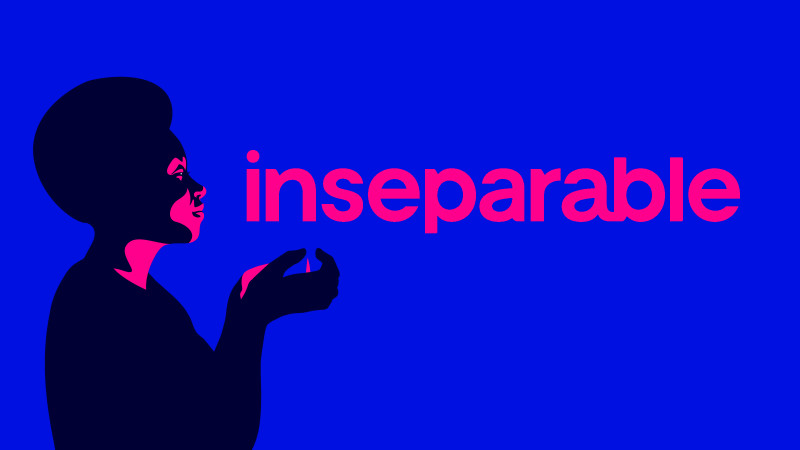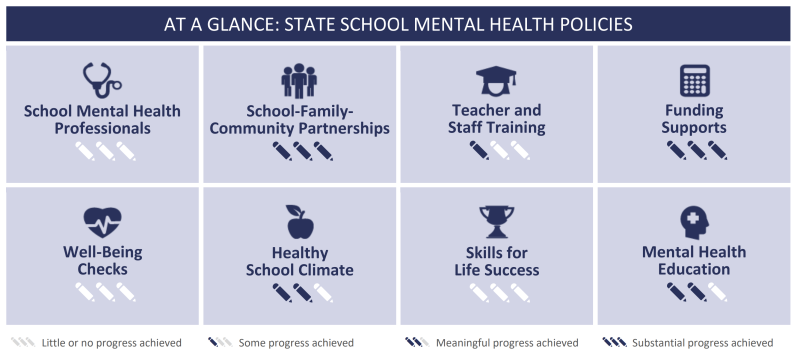

August 17, 2022 | Partner Showcases
Partner Showcase: Inseparable

About Inseparable
Inseparable is a growing coalition of people from across the country who share a common goal to fundamentally improve mental health care policy – to take care of ourselves, our loved ones, and our communities. Inseparable fights for a future where mental health policy, no longer an afterthought, helps our country thrive. Inseparable champions the values of caring, unity, progress, power, and relentless hope. Learn more about Inseparable here .
Inseparable’s Hopeful Futures Campaign
Among Inseparable’s impactful policy efforts is their Hopeful Futures Campaign which focuses on bolstering school-based mental health services through targeted state and federal advocacy strategies. As part of the Hopeful Futures Campaign, Inseparable produced America’s School Mental Health Report Cards for every state. Each state report card includes:
- By the Numbers Overview of Youth Mental Health and School Mental Health Professionals
- Summary of the State’s Progress on School Mental Health Policies
- Identification of State Policy Strengths and Opportunities
- State’s Rankings in Youth Mental Health Compared to the Nation

Example of policy focus areas covered by State Mental Health Report Cards using California’s report card. America’s State Mental Health Report Cards (2022).
Learn more about Inseparable’s State Mental Health Report Cards and actions you can take to create change in your state here.
Interview with Angela Kimball, Senior Vice President of Advocacy and Public Policy, August 12, 2022
What can community-based organizations gain from being involved in mental health policy and advocacy?
- No Money, No Mission. Along with expertise and service, mental health care professionals bring empathy, integrity, passion, and commitment to supporting youth well-being. However, without the funding required to hire staff, create programs, develop care touchpoints, and offer critical mental health resources, this work is often an uphill battle.
- Policy Protections for Youth and Professionals. In many states, providing culturally responsive and gender affirming mental health care has become a politicized issue. Without advocacy to protect youth, their families, and the care professionals who serve them, there may be inhibited access to mental health care and increased stigma surrounding youths’ identities.
What is the most important first step for community organizations looking to plug into local mental health policy and advocacy work?
- Start Small, Think Big. Often, people think that in order to get involved in policy and advocacy, they need to know the existing laws inside and out. Most of the time, that’s not true. If you have subject matter expertise on the issues facing the people you serve, think about the big picture of what needs solving and start putting your voice behind that – whether through an advisory council, city committee, or other means.
- Ask for Help. Everyone starts somewhere. If you don’t know how to read a state budget or pull out the highlights from complex legislative reports, ask around and see if someone in your network does! You would be surprised how many people are happy to help you plug in.
How can an organization identify the ‘right’ person to talk to? What should they look for in a political partner to champion mental health?
- Find funding decision makers. Find out who makes the decisions regarding the state or local budget for funding mental health services provided by your type of organization, such as the state legislature’s Ways & Means Committee. Ask who the chair and ranking member/co-chair of this committee (or relevant subcommittee) is and seek them out. You can also work with multiple members of the committee to elevate your needs.
Once an organization identifies that partner, how can they build a productive relationship that can move the needle for change?
- Develop a genuine relationship based on shared understanding. Our state and local representatives seek to serve their constituents. Help them understand the mental health and well-being concerns facing those constituents and how you are actively helping them solve the problem. People have good intent. Bring that out in them and give them the opportunity to support you. Invite them to your program or share stories from or by the people you serve.
- Connect with the staff of elected officials. Understand that elected officials can be very busy and may rely heavily on their staff. Develop rapport with anyone in the orbit of the elected official – their scheduler, policy director, etc. A few phone calls or even a tweet towards their elected official will be noticed. If the staff notices and remembers you, they can help make those connections with the elected official themselves or may help champion your issue. Staff may be in office longer than the elected official, offering some continuity with a local contact.
What advice would you give to smaller organizations who want to get involved in mental health advocacy, but don’t have the capacity to build these political connections?
- Join state coalitions. Leverage the capacity of an organized group to have your voice heard. You don’t necessarily need to be the one writing the briefs and organizing the logistics of a share-out with state agencies. But you can add your voice, insights, and expertise in determining what priorities that coalition decides to bring forward and how they strategize to get it done.
- Join an Advisory Council . Advisory councils to state and local agencies provide an opportunity to meet state and local officials and learn firsthand what their priorities are. Being a part of an advisory council allows you to commit a little bit of time each month without diving in beyond your capacity, while learning about state agency priorities.
- “Follow the Money, Understand the Law, and Use the Power of the People.” A child psychiatrist once shared this advice with Angela during her early days working in mental health policy and advocacy. It can be a large call to action. Seek out people who can share their knowledge with you and find your partners. If you’re working in mental health, you are already serving the people. Find people with diversified skills that can help you follow the money and understand policy.
How Can Community-Based Organizations Take Action?
Acknowledging the turnover that happens with each election cycle (not to mention a feeling of whip lash in swing states), creating long-term change through local policy and advocacy efforts can feel especially difficult. Here are two ways to take action:
-
Focus your efforts on state mental health agencies with staying power. State agencies and public departments are often comprised of career staff who are employed long before and long after the turnover of each election cycle. By elevating mental health priorities to these departments, you can work towards long-term gains.
-
Join your State's Behavioral Health Advisory Council. Each state receives a Community Mental Health Block Grant and Substance Use Prevention and Treatment Grant from the federal Department of Health and Human Services. These block grants are provided directly to states and are often more flexible than other streams of federal or insurance-tied funding for mental health.
Every state is required to have an Advisory Council comprised of mental health professionals, adults, families, and youth with lived experience with mental health and substance use. The council advises on the state’s behavioral and mental health priorities, recommending where further funding should be invested to see improved outcomes for communities. Look for your state’s Behavioral Health Advisory Council online and reach out to their coordinator for information on council openings and how to join.
To learn more about new federal investments in mental health and how community-based organizations can advocate for mental health funding, check out our latest blog post.


